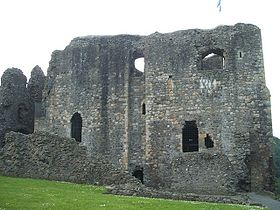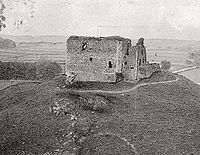- Dundonald Castle
-
This article is about the castle in South Ayrshire. For the castle in Kintyre, see Dundonald Castle, Kintyre.
Dundonald Castle is situated on a hill overlooking the village of Dundonald, between Kilmarnock and Troon in South Ayrshire, Scotland. Dundonald Castle is a fortified tower house built for Robert II on his accession to the throne of Scotland in 1371 and it was used as a royal residence by the early Stewart kings for the next 150 years.
Contents
History
Dark age hill fort
The present castle stands on land where evidence suggest there used to be a hill fort. It is thought that a mixture of large timber built round houses and straight-sided structures occupy the interior. A timber laced stone rampart defines and defends the hill fort. The timber lacing caught fire and burnt with such intensity that the surrounding stonework melted, or vitrified. This firing happened about 1000 AD and seems to mark the end of the hill-fort’s existence.
It was about this date that the independence of the British Kingdom of Strathclyde ceased, being absorbed into the kingdom of Scotland.
The place name Dundonald means “Donald’s Fort”. Historians do not know who Donald was but he may have been one of three kings of that name who ruled in Strathclyde in the 10th century.
Early castles
There have been three medieval castles present on this site. The first was built by one of the stewards of the king of Scots, most probably Walter, the first steward, who came to Scotland in 1136. There is no surviving evidence of this castle above ground today.
The second castle was built in the late 13th Century by Alexander Stewart, 4th High Steward, this castle was predominantly built of stone. It would have been one of the grandest baronial residences of its time. It was largely destroyed by the English during the Wars of Scottish Independence wars of independence in the early 14th century. There is little remaining of this castle, however there is a well and a rounded stump of a tower near to the present castle.
The present castle
The third castle was built by Robert Stewart, probably to mark his accession to the throne as Robert II in 1371. It was three storeys high.
The top floor above the lofty stone vault was the upper hall – the great hall. It was for the more private use of the king and family.
The first floor was the lower of the two halls – the laigh hall. It would have been used for more public activities like feasting and the holding of the baron court.
The ground floor was a storage area. It was probably originally subdivided providing cellars for different commodities like wine, ale, foodstuffs and fuel.
The tower house was extended in the 15th century to add additional private chambers and a prison. The outer courtyard (called more properly the barmkin) was completed and ancillary buildings (stables, bakehouses, brewhouses, smithy, etc) built against the barmkin wall.
The third castle comprises almost everything you see above ground today, including the tower which dominates the hill.
Dundonald castle once had its own chapel dedicated to Saint Inan.[1]
The castle today
There is a visitor centre at the foot of the hill, which includes a cafe, souvenir shop and an interpretive exhibition. The exhibition outlines the history of the Castle and its preceding buildings with detailed models of the earlier castles on the site.
The visitor centre is owned by South Ayrshire Council and is operated on their behalf by The Friends of Dundonald Castle.
The legend of Dundonald Castle
The following extract alludes to an old Scottish folktale about the construction and origins of Dundonald Castle:
In Ayrshire, the following rhyme is prevalent, and is probably very old:
Donald Din
Built his house without a pin,alluding to Dundonald Castle, the ancient seat of King Robert II, and now the last remaining property in Ayrshire of the noble family who take their title from it. According to tradition, it was built by a hero named Donald Din, or Din Donald, and constructed entirely of stone, without the use of wood, a supposition countenanced by the appearance of the building, which consists of three distinct stories, arched over with strong stonework, the roof of one forming the floor of another.
Donald, the builder, was originally a poor man, but had the faculty of dreaming lucking dreams. Upon one occasion he dreamed, thrice in one night, that if he were to go to London Bridge, he would become a wealthy man. He went accordingly, saw a man looking over the parapet of the bridge, whom he accosted courteously, and, after a little conversation, entrusted with the secret of the occasion of his coming to London Bridge.
The stranger told him that he had made a very foolish errand, for he himself had once had a similar vision, which directed him to go to a certain spot in Ayrshire, in Scotland, where he would find a vast treasure, and, for his part, he had never once thought of obeying the injunction.
From his description of the spot, the sly Scotsman at once perceived that the treasure in question must be concealed in no other place than his own humble kail-yard [cabbage patch] at home, to which he immediately repaired, in full expectation of finding it. Nor was he disappointed; for, after destroying many good and promising cabbages, and completely cracking credit with his wife, who esteemed him mad, he found a large potful of gold coin, with the proceeds of which he built a stout castle for himself, and became the founder of a flourishing family.[2]
Legend origines
Main article: The Alchemist (book)#InspirationSimilar legends can be found throughout Europe and the Middle-East.[3] The earliest version is one of the poems of the Mathanawi titled "In Baghdad, Dreaming of Cairo: In Cairo, Dreaming of Baghdad", by 13th century Persian poet Jalal al-Din Rumi;.[4] This poem was turned into a story in the tale from The One Thousand and One Nights: The man who became rich through a dream;[5] and spread through various countries folklore, children's tales and literature. More recently the story was adapted into the plot of the novel The Alchemist by Paulo Coelho.
Micro-history
A ley tunnel is said to run from Seagate Castle in Irvine to Dundonald Castle.[6]
References
- ^ McJannet, Arnold F. (1938), The Royal Burgh of Irvine. Glasgow : Civil Press. p. 14.
- ^ The popular rhymes of Scotland; By Robert Chambers; Published by W. Hunter, 1826
- ^ www.pitt.edu
- ^ The Essential Rumi, transl. Coleman Barks, New York: HarperCollins, 1995
- ^ The Book of the Thousand Nights and a Night, (The Man Who Became Rich through a Dream) translated by Richard F. Burton (London: The Burton Club, 1885), vol. 4, pp. 289-90. Translation revised by D. L. Ashliman
- ^ Strawhorn, John (1994). The History of Irvine. Edinburgh : John Donald. ISBN 0-85976-140-1. p. 35
External links
Categories:- Historic Scotland properties
- Castles in South Ayrshire
- Category A listed buildings in Scotland
- Listed buildings in South Ayrshire
- Listed castles in Scotland
- Historic house museums in South Ayrshire
Wikimedia Foundation. 2010.


